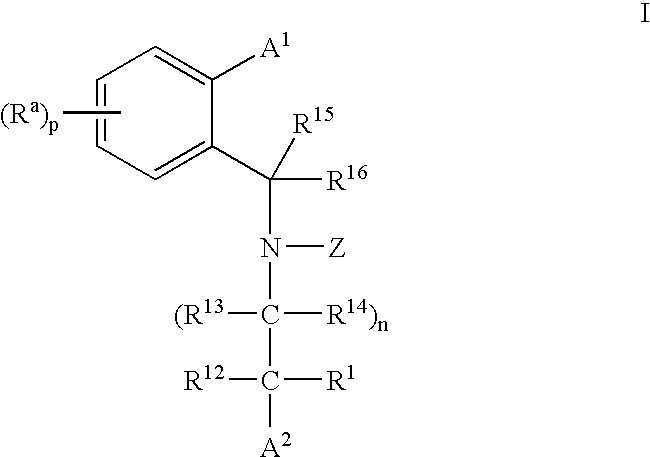CETP inhibitors
a technology of hdl-c and inhibitors, applied in the field of ccetp inhibitors, can solve the problems of chd risk, high risk of statins, and true burden on health care systems, and achieve the effect of only reducing the risk of approximately one-third
- Summary
- Abstract
- Description
- Claims
- Application Information
AI Technical Summary
Benefits of technology
Problems solved by technology
Method used
Image
Examples
example 1
[0182]
2-Amino-5-(trifluoromethyl)benzonitrile
[0183]In a 2-liter flask equipped with a septum inlet, magnetic stirring bar, and condenser leading to a mercury bubbler was placed 100 g (0.348 mol) of 4-amino-3-iodobenzotrifluoride in 1 liter DMF. To this reaction flask with stirring was added 37.4 g (0.416 mol) of copper cyanide and the contents were heated to 100° C. under nitrogen for fourteen hours. Afterwards, TLC analysis revealed minor starting material (20 / 80) ethyl acetate / hexane. The contents were cooled to 40° C. and filtered through a pad of Celite. The solids were washed with ether and the filtrate transferred to a separatory funnel and washed with about 5% aqueous ammonium hydroxide. The aqueous layer was back-extracted with ether and the organics were combined and washed with brine, dried over magnesium sulfate, filtered and concentrated to yield a black oil. The oil was chromatographed on a Biotage 75L cartridge with ethyl acetate / hexane to obtain 68 g 2-amino-5-(triflu...
example 2
[0184]
[2-(Aminomethyl)-4-(trifluoromethyl)phenyl]amine
[0185]In a rocker shaker was charged 37 g (0.2 mol) of 2-amino-5-(trifluoromethyl)benzonitrile in 500 mL of ethanol and 76 mL of ammonium hydroxide. The contents were degassed / blanketed with nitrogen, 25 g of Raney nickel were added, then the shaker was pressurized with 40 psi hydrogen gas. At 15 hours TLC analysis (20 / 80 ethyl acetate / hexane) revealed no starting material. The contents were filtered through Celite and washed with ether and concentrated to 37 g black oil. The oil was chromatographed on a Biotage 75L cartridge with methanol / methylene chloride and ammonium hydroxide / methanol / methylene chloride to give [2-(aminomethyl)-4-(trifluoromethyl)phenyl]amine as a green oil.
example 3
[0186]
[2-Amino-5-(trifluoromethyl)benzyl][3,5-bis(trifluoromethyl)benzyl]amine
[0187]In a 500-mL flask equipped with a septum inlet, magnetic stirring bar, and condenser leading to a mercury bubbler was placed 22.8 g (0.12 mol) of [2-(aminomethyl)4-(trifluoromethyl)phenyl]amine in 218 mL dimethoxyethane. To this reaction flask with stirring was added 26 mL (0.24 mol) N-methylmorpholine and 24 mL (0.13 mol) 3,5-bis(trifluoromethyl)benzyl bromide. The contents were heated to and maintained at reflux under nitrogen for 12 hours. Afterwards, TLC analysis revealed a minor amount of starting material remaining. The contents were cooled to room temperature, diluted with ether and transferred to a separatory funnel and washed with water and brine, dried over magnesium sulfate, filtered and concentrated to afford an oil. The oil was dissolved in hexane, cooled in an ice bath and acetic acid was added slowly while stirring to precipitate solids. The solids were filtered, dissolved in ether, an...
PUM
| Property | Measurement | Unit |
|---|---|---|
| density | aaaaa | aaaaa |
| volume | aaaaa | aaaaa |
| volume | aaaaa | aaaaa |
Abstract
Description
Claims
Application Information
 Login to View More
Login to View More - R&D
- Intellectual Property
- Life Sciences
- Materials
- Tech Scout
- Unparalleled Data Quality
- Higher Quality Content
- 60% Fewer Hallucinations
Browse by: Latest US Patents, China's latest patents, Technical Efficacy Thesaurus, Application Domain, Technology Topic, Popular Technical Reports.
© 2025 PatSnap. All rights reserved.Legal|Privacy policy|Modern Slavery Act Transparency Statement|Sitemap|About US| Contact US: help@patsnap.com



